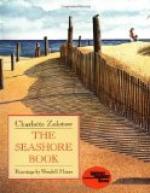Oysters feed in rather a strange way. You may have looked inside the shells and seen two delicate dark-edged fringes, known as the “beard.” This fringe is the Oyster’s gills or breathing arrangement. Trace the “beard” as far as the hinge of the shells, and you see the mouth with its white lips. If you could watch the creature having its dinner, you would see a constant stream of water flowing over the gills and towards the mouth.
What makes the water move in that way? The gills are covered with very tiny lashes, like little hairs. There are so many of them that, as they keep moving, they force the water along, over the gills and towards the mouth. In this way the Oyster breathes the air which is in the water; but not only that. As we have already noticed, there is a kind of “vegetable dust” in the sea. This is driven to the Oyster’s mouth and swallowed. The Oyster, fixed in its “bed,” unable to hunt for food, thus makes its dinner come to it. What a strange use for a “beard”! It not only serves as lungs, but also helps the animal to catch its “daily bread”!
Another mollusc used as food is the Cockle, and its shell is one of the commonest found along the shore, especially near sandy places. It lives in sand, and can bury itself so quickly that you would have to use your spade with all your might in order to keep pace with this little shell-fish. Where Cockles have buried themselves you will see spurts of water and sand, showing where they are busy down below in the wet sand.
Besides being so skilful at digging, the Cockle is a first-rate jumper. If left on the beach, it jumps over the sand, towards the sea, in the funniest way. It is strange to see a quiet-looking shell suddenly take to hopping and jumping like an acrobat.
To perform this astonishing feat the Cockle makes use of its foot, which is worked by very strong muscles. It is large and pointed, and bent: if the Cockle wishes to move quickly, it stretches out its foot from between the shells, as far as it will go. Then, by using all its power, it leaps backwards or forwards in a surprising manner.
There are many other interesting molluscs, besides those we have looked at. The Piddock, or Pholas, is a smallish, rather delicate one, with a soft foot. But this foot is a most wonderful boring tool, fitted with a hard file. Hard rocks and wood are perforated by these little molluscs. Indeed, they are a positive danger, for they pierce the wooden piles of piers, and weaken them. They cannot pierce through iron, however, and so iron plates or nails are used to protect the piles from their onslaughts. You will often see stones and rocks riddled by the Piddock as if they were as soft as cheese. Chalk, sandstone, or oak, it is all the same to the Piddock, which rasps them away with its file. When the points of this strange instrument are worn out with all this hard wear, a new set takes their place.




